全文HTML
--> --> -->毛细管微会聚X光透镜可以将X射线管出射的X射线束从毫米量级逐渐会聚到微米量级, 不仅能使照射X射线的强度增强数十倍, 同时可保持透镜出口端X射线束的发散度在水平和垂直方向上为0.15°左右[11]. 因而会聚后X射线束照射在表面不平整样品上时, X射线衍射峰位不会因样品表面存在的空隙、弯曲度或不平整而发生偏移, 从而能极大地提高X射线衍射分析的强度、准确性和灵敏度[12]. 除此之外, 还可以通过改变透镜出口端与样品照射点的相对距离来改变照射X射线的束斑直径, 使得照射X射线的束斑直径不仅能满足毫米量级的常规X射线衍射分析, 还能满足微米量级的微区X射线衍射分析.
综上所述, 为同时实现微区物相分析、常规物相分析以及对表面不平整样品准确的物相分析, 并且可以根据待分析区域大小自适应地调节照射X射线束斑直径等功能, 本实验室结合毛细管微会聚X光调控技术、X射线衍射技术和CCD相机成像技术研制了一款适用于多领域的点光源自适应束斑X射线衍射仪, 并且针对相应的分析方法学展开了研究.
2.1.自适应X射线束斑的实现
Hawk-II的自适应调节X射线束斑直径的功能是通过CCD相机成像技术和毛细管微会聚X射线调控技术的特点来实现的. 毛细管X光透镜束斑直径(full width at half maxima, FWHM)与探测点到透镜出口端距离F之间的关系如图1[13]所示, 从透镜出口端到焦斑处X射线束的直径逐渐变小[13]. 因此, 通过改变透镜出口端与探测点F可以获得不同直径的照射X射线束斑. Hawk-II所采用的毛细管微会聚X光透镜聚焦X射线的束斑变化示意图如图2所示. 由刀口扫描法[14]测得选用的毛细管微会聚X光透镜在Cu-Kα(8.04 keV)能量下焦斑F2处的束斑直径最小约为680 μm, 透镜出口端的束斑直径最大约为1300 μm. 自适应调节X射线束斑直径的具体过程如下: 首先由CCD相机实时观测样品待测区域, 在CCD相机视野里框选出待测区域的内切圆, 接着由测量软件计算出待测区域内切圆的直径并将数据传输给计算机, 再由计算机控制光管运动系统沿X射线轴线运动, 使照射X射线束斑直径与实际待测区域内切圆的直径相符, 以实现根据实际待测区域大小自适应调节照射X射线束斑直径的功能.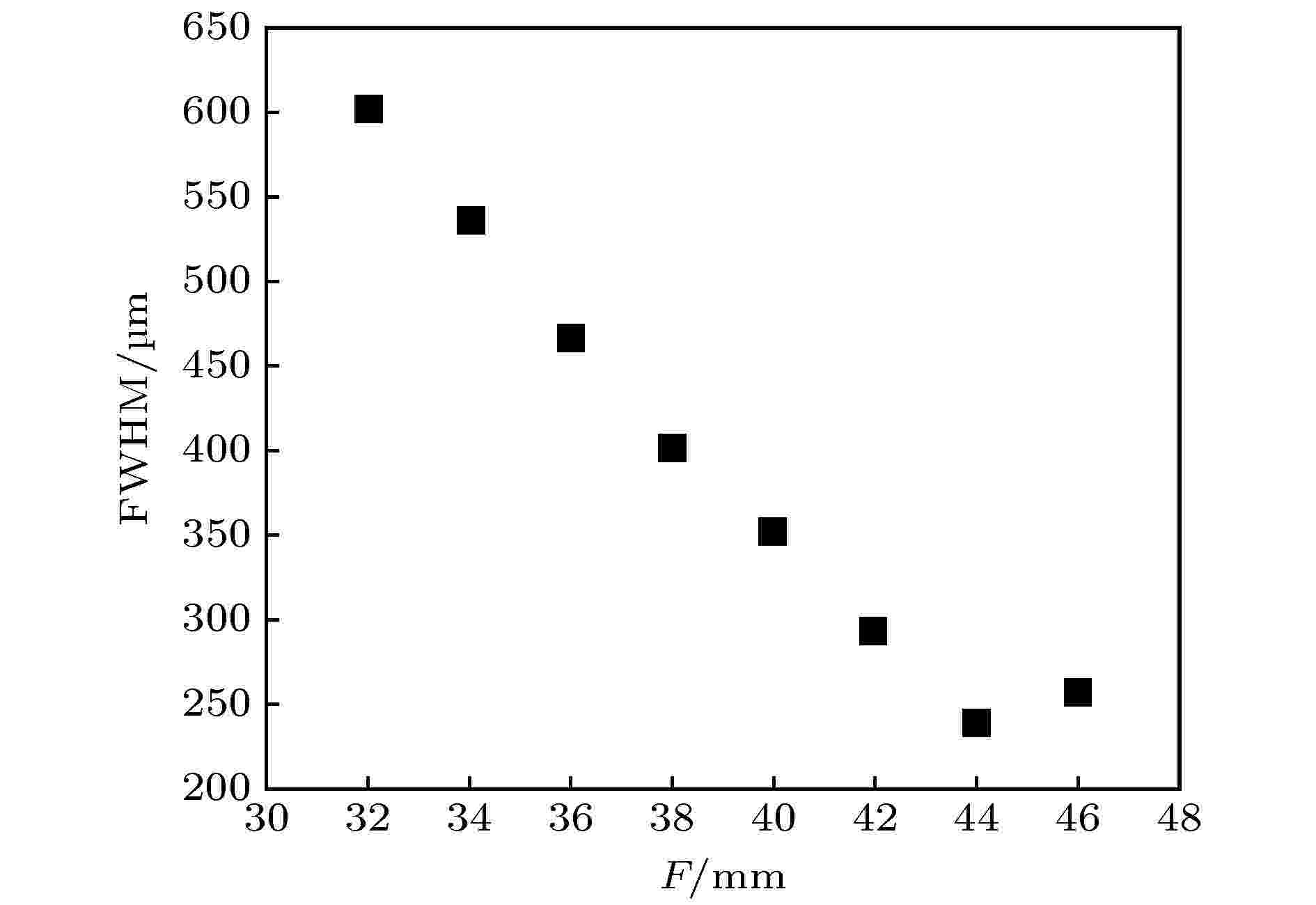 图 1 透镜束斑大小(FWHM)与探测点到透镜出口端距离(F)之间的关系
图 1 透镜束斑大小(FWHM)与探测点到透镜出口端距离(F)之间的关系Figure1. The FWHM of X-ray beam spots varied with the distances (F) from the measured spots to the exit of polycapillary X-ray optics.
 图 2 毛细管微会聚X光透镜聚焦X射线的束斑变化示意图
图 2 毛细管微会聚X光透镜聚焦X射线的束斑变化示意图Figure2. Diagram of changes in beam spot size of X-ray focus by the slightly-focusing polycapillary X-ray optics.
2
2.2.Hawk-II的组成
Hawk-II主要由X射线源系统、六维联动运动系统、CCD相机、X射线探测系统和软件控制系统组成, 其结构如图3所示. X射线源系统由X射线管(Cu靶, 荷兰PHILIPS, 1 mm × 1 mm点光源, 最大功率为2600 W)、毛细管微会聚X光透镜(后焦距为200 mm, 焦斑为680 μm)、吸收片(Ni, 厚度为17 μm)、闭环水冷系统和高压电源组成. 六维联动运动系统包括一维光管运动系统、二维θ-2θ角扫描系统和三维样品台运动系统, 其中一维光管运动系统可以沿X射线轴向运动来调整透镜出口端相对于样品的距离; 二维θ-2θ角扫描系统由两个联动的转角组成, 可以实现X射线衍射分析所需的角扫描; 三维样品台运动系统控制样品运动使待测点保持在角扫描系统的轴心上. CCD相机具有20倍的放大功能、1400万像素. X射线探测系统由X射线探测器、集成式脉冲分析器和索拉狭缝组成, 探测器和分析器采用美国Amptek 公司的SDD X射线探测器(Be窗有效面积为25 mm2, 厚度为8 μm, 5.9 keV能量处FHWM = 130 eV)和PX5单/多通道数字脉冲分析器. 软件控制系统包括计算机、可编程逻辑控制器(programmable logic controller, PLC)和基于LabVIEW的控制软件组成. 由控制软件输入信号再传递给PLC, 由PLC发出脉冲信号给六维联动运动系统的电机使其运动. 控制系统通过调用PX5的单通道脉冲分析功能启动衍射分析模式, 调用PX5的多通道脉冲分析功能启动荧光分析模式.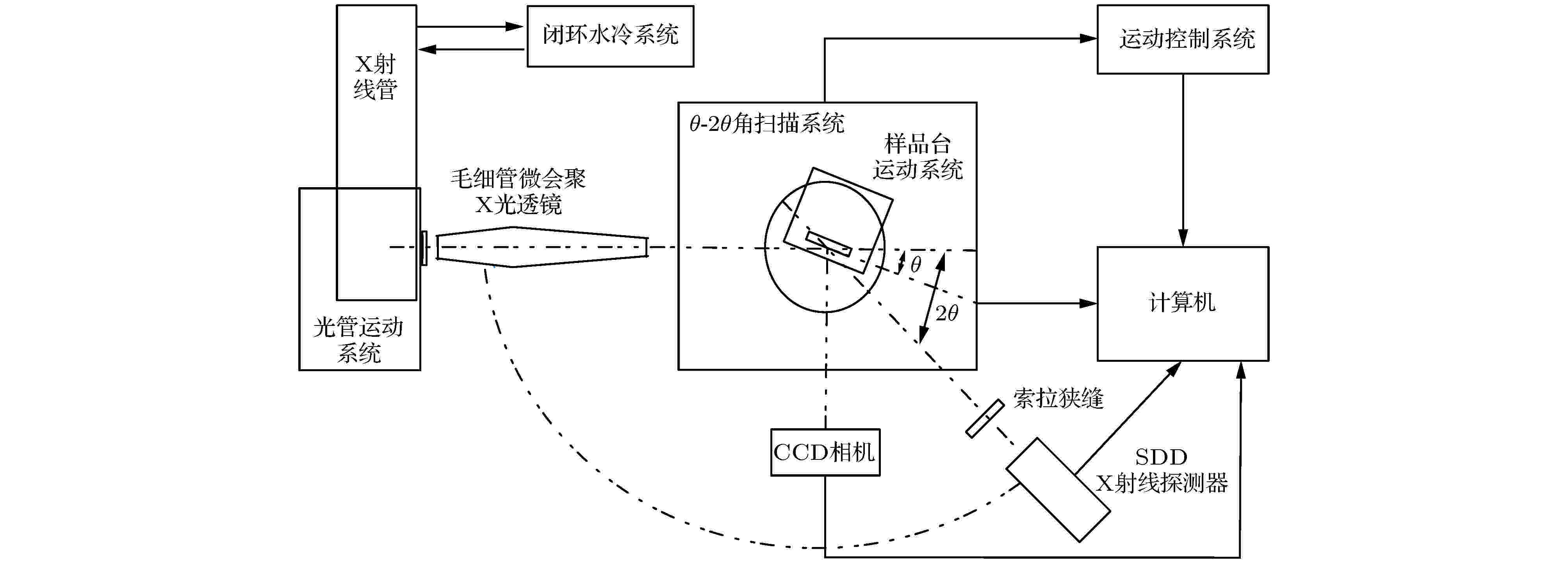 图 3 点光源的自适应束斑X射线衍射仪(Hawk-II)结构示意图
图 3 点光源的自适应束斑X射线衍射仪(Hawk-II)结构示意图Figure3. The schematic diagram of adaptive beam spot X-ray diffractometer with point source (Hawk-II).
2
2.3.Hawk-II的性能参数
32.3.1.单色化
Hawk-II采用17 μm厚的Ni吸收片做为单色器吸收来自Cu靶的Cu-Kβ, 为X射线衍射分析提供所需的单色化X射线. 加Ni吸收片和不加Ni吸收片的X射线散射光谱[15]如图4所示, 其实验条件为: 电压40 kV, 电流2 mA, 探测时间300 s. 由图4可以得出, 加Ni吸收片后Cu-Kα的强度占总X射线强度的比值由84.48%上升到99.62%, 而Cu-Kβ的强度比值由13.99%降低到0.27%, 因此经过Ni吸收片后的X射线为Cu-Kα的单色X射线.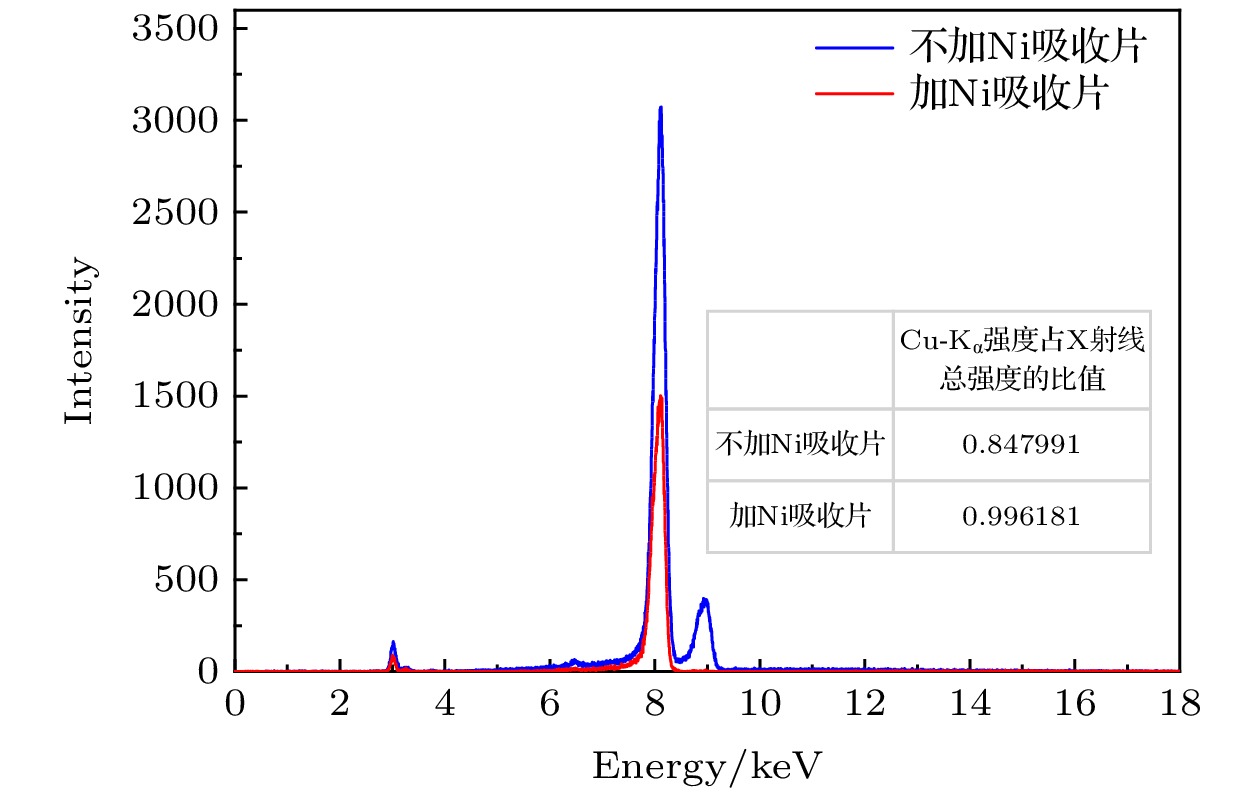 图 4 加Ni吸收片和不加Ni吸收片两种条件下的X射线散射谱
图 4 加Ni吸收片和不加Ni吸收片两种条件下的X射线散射谱Figure4. X-ray scattering spectra with and without Ni filter.
3
2.3.2.测量准确度
衍射仪固有的角度测量准确度直接影响物相分析结果的准确性[16]. 为了验证Hawk-II的测量准确度, 选取衍射峰位于10°到120°之间低角度、中角度和高角度的三种标准物质: 单晶Si(1 1 1)(JCPDS 75-0590), 单晶Si(4 0 0)(JCPDS 75-0590)和单晶GaAs(5 1 1)(JCPDS 29-0615)进行X射线衍射分析. 所测得的三种标准物质的衍射图叠加在图5中, 实验条件为: 电压30 kV, 电流30 mA, 步距角0.1°, 探测时间0.5 s, 照射X射线束斑直径1300 μm. 从图5可以看出, Hawk-II所测得的衍射峰位与三种标准物质的PDF卡的衍射峰位(图5中虚线所示)符合得很好. 表1展示了三种标准物质衍射峰位的测量值与PDF卡的对比, 分析可知Hawk-II测得的每个衍射峰的角度误差都小于0.01°. 以上分析结果表明, Hawk-II具有较高的测量准确度.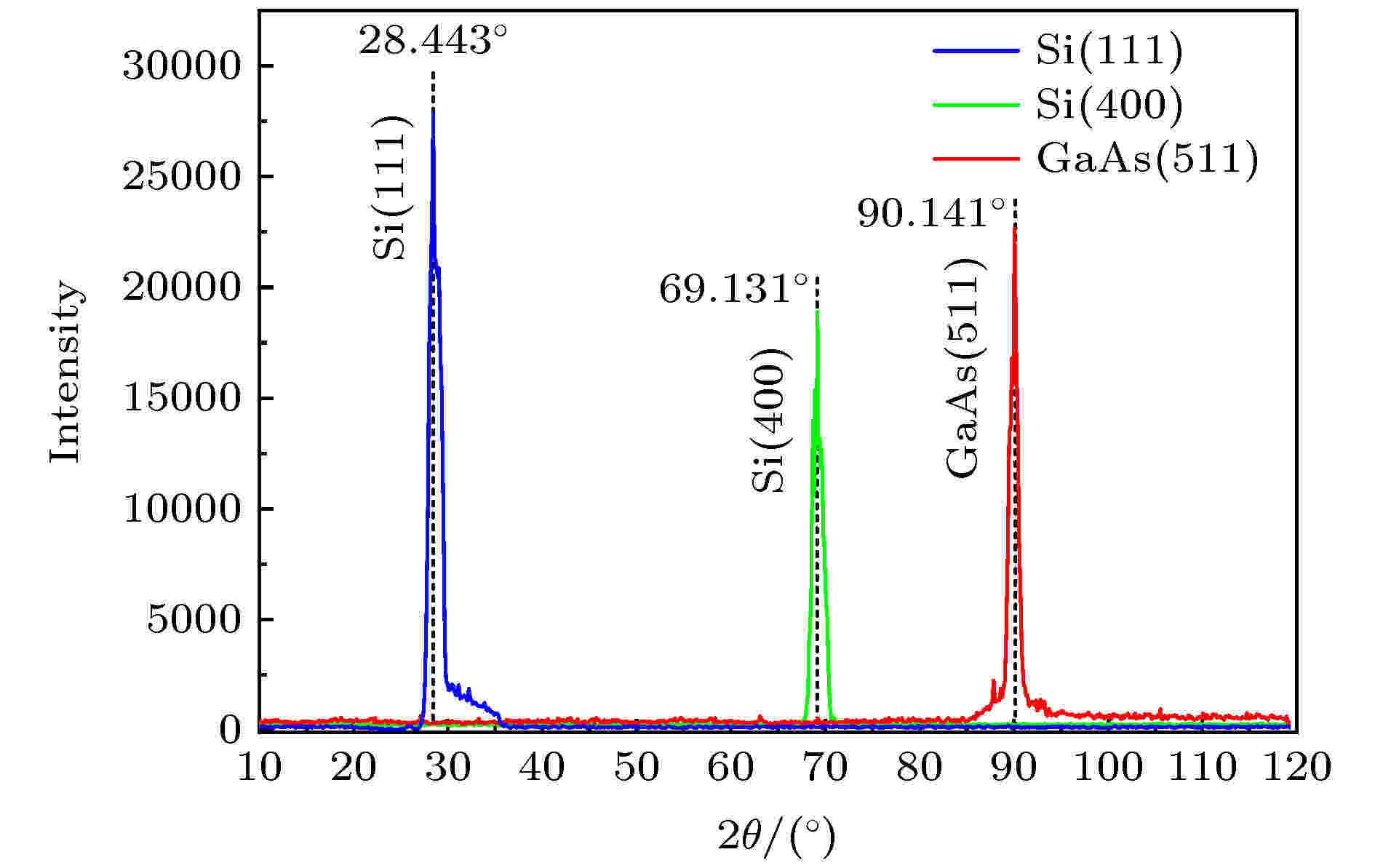 图 5 Si (1 1 1), Si (4 0 0)和GaAs (4 1 1)的衍射图
图 5 Si (1 1 1), Si (4 0 0)和GaAs (4 1 1)的衍射图Figure5. The XRD patterns of Si (1 1 1), Si (4 0 0) and GaAs (4 1 1) crystals.
| 参考数据 | 测量数据 | |||
| PDF卡 | 2θ/(°) | (h k l) | 2θ/(°) | |
| Si(JCPDS 75-0590) | 28.443 | (1 1 1) | 28.441 | |
| Si(JCPDS 75-0590) | 69.131 | (4 0 0) | 69.136 | |
| GaAs(JCPDS 29-0615) | 90.141 | (5 1 1) | 90.132 | |
表1Si (1 1 1), Si (4 0 0)和GaAs (4 1 1)的测量数据对比
Table1.The comparison of measurement data of Si (1 1 1), Si (4 0 0) and GaAs (4 1 1).
3.1.表面不平整样品的物相分析
为探究Hawk-II分析表面不平整样品的可行性, 选取一枚表面凹凸不平的人民币五角硬币作为样品, 分别使用Hawk-II与X-pert-pro-MPD(荷兰, 帕纳科)X射线衍射仪对样品进行物相结构分析. 样品及待测点如图6所示, Hawk-II的照射X射线束斑直径约为1300 μm. 其实验条件如表2所示, 测得的衍射图如图7所示.| Hawk-II | X-pert-pro-MPD | |
| 靶材料 | Cu | Cu |
| 单色器 | Ni吸收片 | Ni吸收片 |
| 束斑尺寸/mm | 1.3 × 1.3 | 1 × 10 |
| 电压/kV | 40 | 40 |
| 电流/mA | 40 | 40 |
| 步距角/(°) | 0.15 | 0.03 |
| 探测时间/s | 2 | 20 |
表2两种衍射仪的实验条件对比
Table2.Measurement conditions of two diffractometers.
 图 6 人民币五角硬币及其测试点
图 6 人民币五角硬币及其测试点Figure6. The RMB 5 Jiao coin and the detected point.
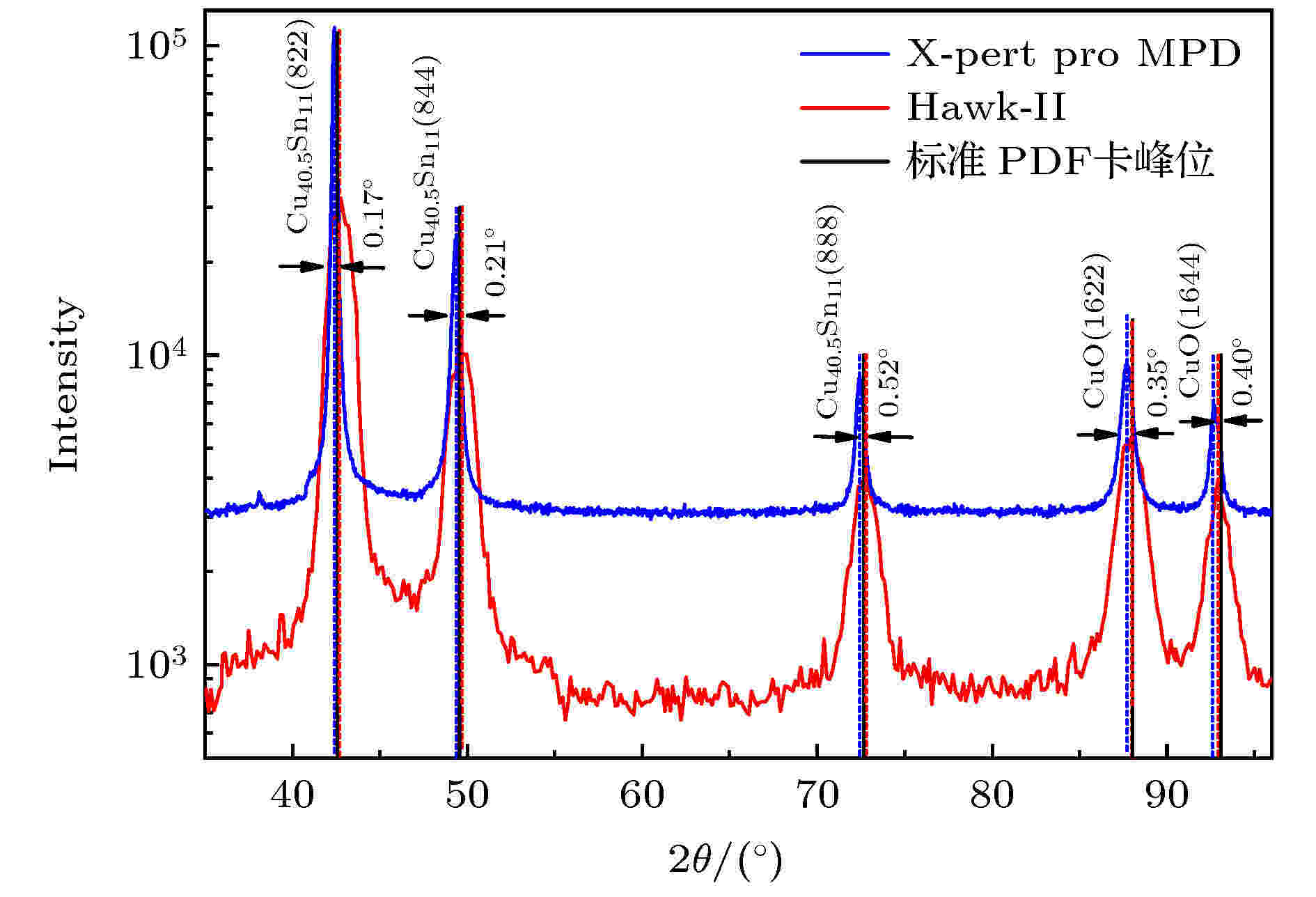 图 7 两种衍射仪测量人民币五角硬币的衍射图
图 7 两种衍射仪测量人民币五角硬币的衍射图Figure7. The XRD patterns of the RMB 5 Jiao coin measured by two kinds of diffractometers.
由图7可以得出, 二种衍射仪测得的衍射峰数量一致, 与标准PDF卡进行比较可知, 人民币五角硬币的主要物相为铜锡合金Cu40.5Sn11(JCPDS 31-0485)和CuO(JCPDS 48-1548). X-Pert Pro MPD所测得的衍射图峰位(图7中蓝虚线)与标准 PDF卡(图7中黑实线)相比发生了较大的偏移, 在Cu40.5Sn11(8 8 8)晶面处的偏移角度高达0.52°, 而Hawk-II测得的衍射图峰位(图7中红虚线)与标准PDF卡几乎完全一致. 衍射图中强度的不同是由于仪器探测时间不同所导致, X-Pert Pro MPD和Hawk-II的探测时间分别为20和2 s. 而Hawk-II所测得的衍射峰发生展宽是因为采用毛细管微会聚X光透镜作为聚焦器件, 从透镜出射的X射线束除中心的大部分平行光外, 其外围的会聚X射线束相对于平行光具有一定的角度导致衍射峰展宽. 该实验证明Hawk-II对比常规X射线衍射仪在测量表面不平整样品时具有更大优势.
2
3.2.不同直径X射线束斑的物相分析与比较
为探究不同直径的照射X射线束对物相分析的影响, 分别选取清代红绿彩瓷残片和表面镀20 nm厚的 Cu和Fe纳米薄膜材料为待测样品, 对其进行不同直径X射线束斑的物相分析并对结果进行比较分析.3
3.2.1.清代红绿彩瓷白釉的物相分析
对一块清代红绿彩瓷残片的白釉分别采用直径为680和1300 μm的X射束进行衍射分析, 分析结果如图8所示. 实验条件为: 电压30 kV, 电流30 mA, 步距角0.15°, 探测时间5 s. 分析图8可知, 清代红绿彩瓷白釉的主要晶相为钾长石KAlSi3O8(JCPDS 09-0462)和莫来石3Al2O3·2SiO2 (JCPDS 02-0452). 两种X射线束斑下所测得的衍射图峰形和衍射图强度都较为相似, 虽然采用的照射X射线束斑直径不同但是X射线总照射强度却并未改变, ,而两种X射线束斑下的衍射强度变化不明显,说明清代红绿彩瓷白釉的晶相分布比较均匀. 由于直径为1300 μm的X射线束斑照射面积更大, 照射范围内的某些微晶数量更高, 其衍射峰能更好地呈现出来, 所以衍射图中部分弱峰只有采用直径为1300 μm的X射线束才能探测到. 衍射图中20°到30°之间的弥散峰主要是瓷釉在烧制过程中所形成的非晶相所致.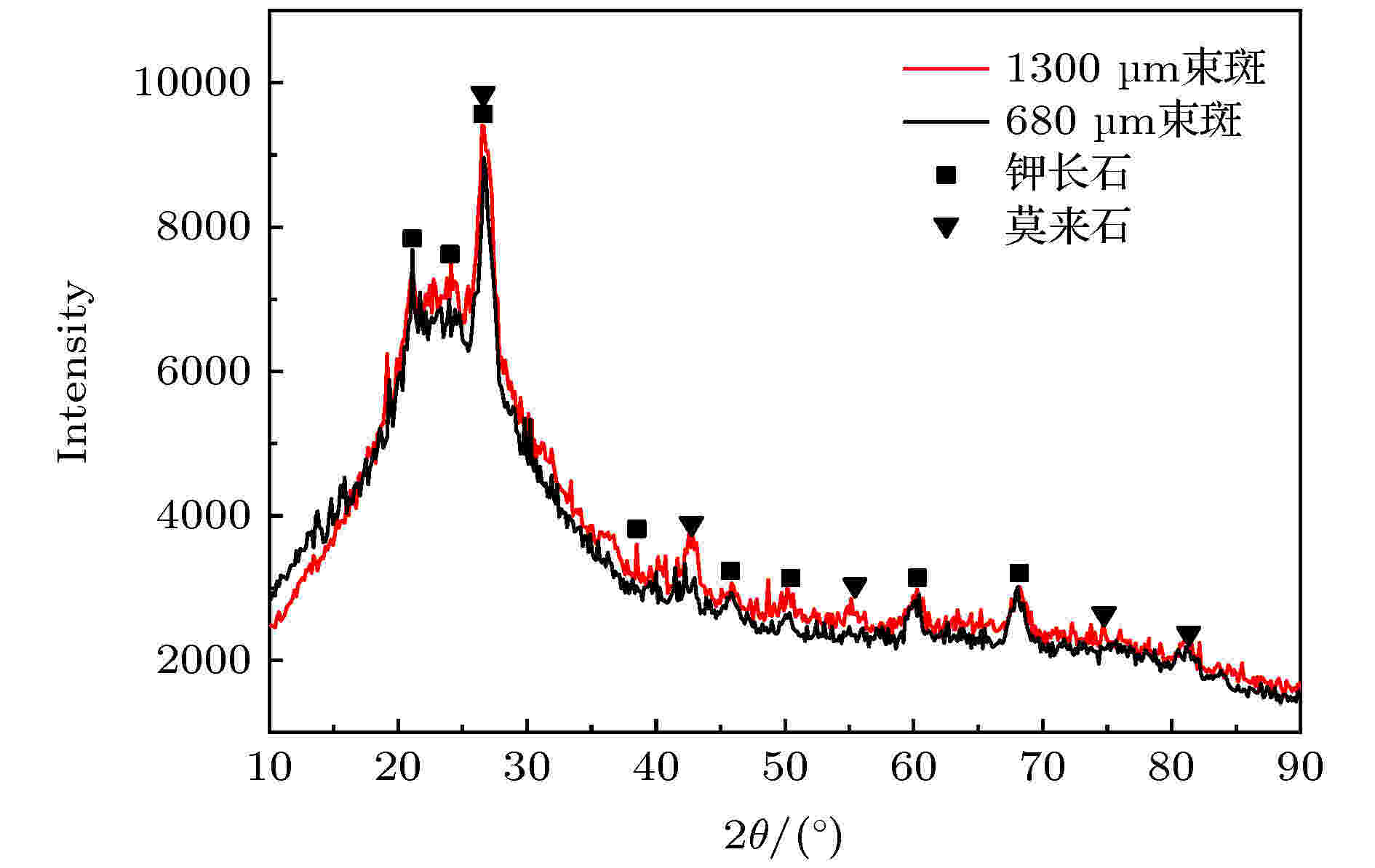 图 8 清代红绿彩瓷白釉不同照射束斑的衍射图对比
图 8 清代红绿彩瓷白釉不同照射束斑的衍射图对比Figure8. The comparison of XRD patterns of Qing Dynasty red and green porcelain white glaze with different beam spots.
3
3.2.2.纳米薄膜材料的物相分析
选取GaAs(1 0 0)单晶为基底, 表面镀20 nm厚的 Cu和Fe纳米薄膜材料为样品[17](采用的镀膜方法为金属蒸汽真空弧离子源法), 分别使用直径为680和1300 μm的照射X射线束对纳米薄膜样品进行物相分析, 实验结果如图9所示. 实验条件为: 电压30 kV, 电流30 mA, 步距角0.15°, 探测时间1 s. 分析图9可知, 不同直径的X射线束斑所测得的晶相相同, 为CuO(JCPDS 02-1041)和Fe2O3(JCPDS 24-0072)的晶相, 这两种晶相是由薄膜中的Cu和Fe在空气中氧化所形成. 衍射图中晶相的峰面积出现了较大变化, 相比于直径为680 μm的X射线束斑, 在直径为1300 μm的X射线束斑下Fe2O3晶相的峰面积增加了近2倍, 而CuO晶相的峰面积增加了1.5倍左右, 这表明不同X射线束斑照射范围内同一晶相的密度不同, 并且两种晶相的分布相互之间也不成比例, 因此可以推断该纳米薄膜材料表面的Cu和Fe镀膜分布不均匀[17].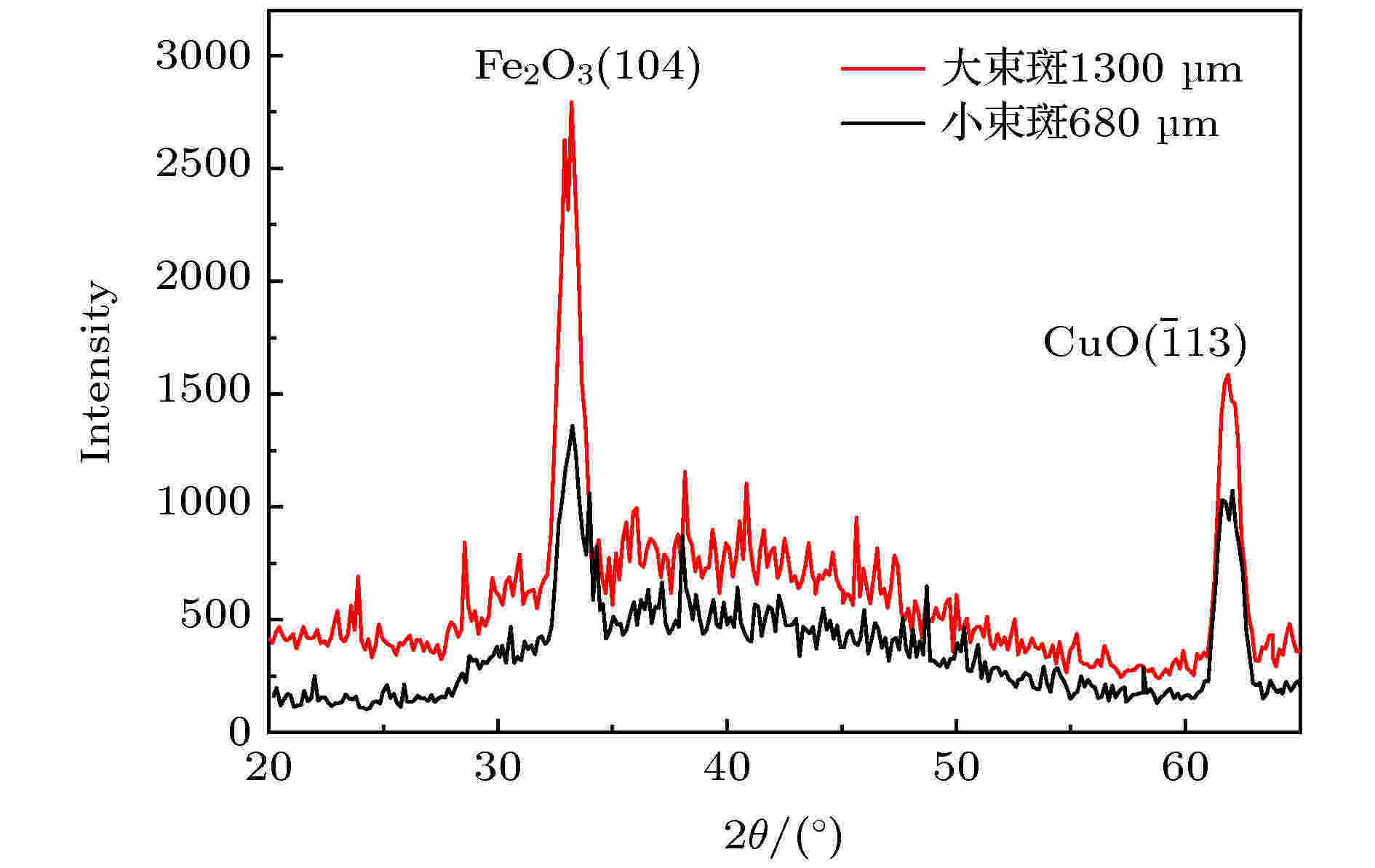 图 9 GaAs为基底表面镀Cu和Fe的纳米薄膜在不同照射束斑下的衍射图对比
图 9 GaAs为基底表面镀Cu和Fe的纳米薄膜在不同照射束斑下的衍射图对比Figure9. The comparison of XRD patterns of GaAs based Cu and Fe plated film with different beam spots.
综合以上两个采用不同照射X射线束斑的实验可知, 在不限制待测区域面积的前提下, 更大的照射X射线束斑可以获得更多细节的衍射数据信息. 因此, 为保证获得待测区域内所含的完整衍射信息, 应使X射线照射区域与待测区域相符.
2
3.3.自适应束斑在分析古青铜样品中的应用
为验证Hawk-II自适应调节照射X射线束斑的功能, 选取一块西汉青铜碎片做为样品, 其不同锈蚀点的面积大小不一并且锈蚀表面不平整, 为准确地探测到锈蚀点所有的物相信息, 应使X射线照射区域与锈蚀区域相符. 选取如图10所示的青铜绿锈、红锈、黑锈和截面做为待测点对其进行物相分析.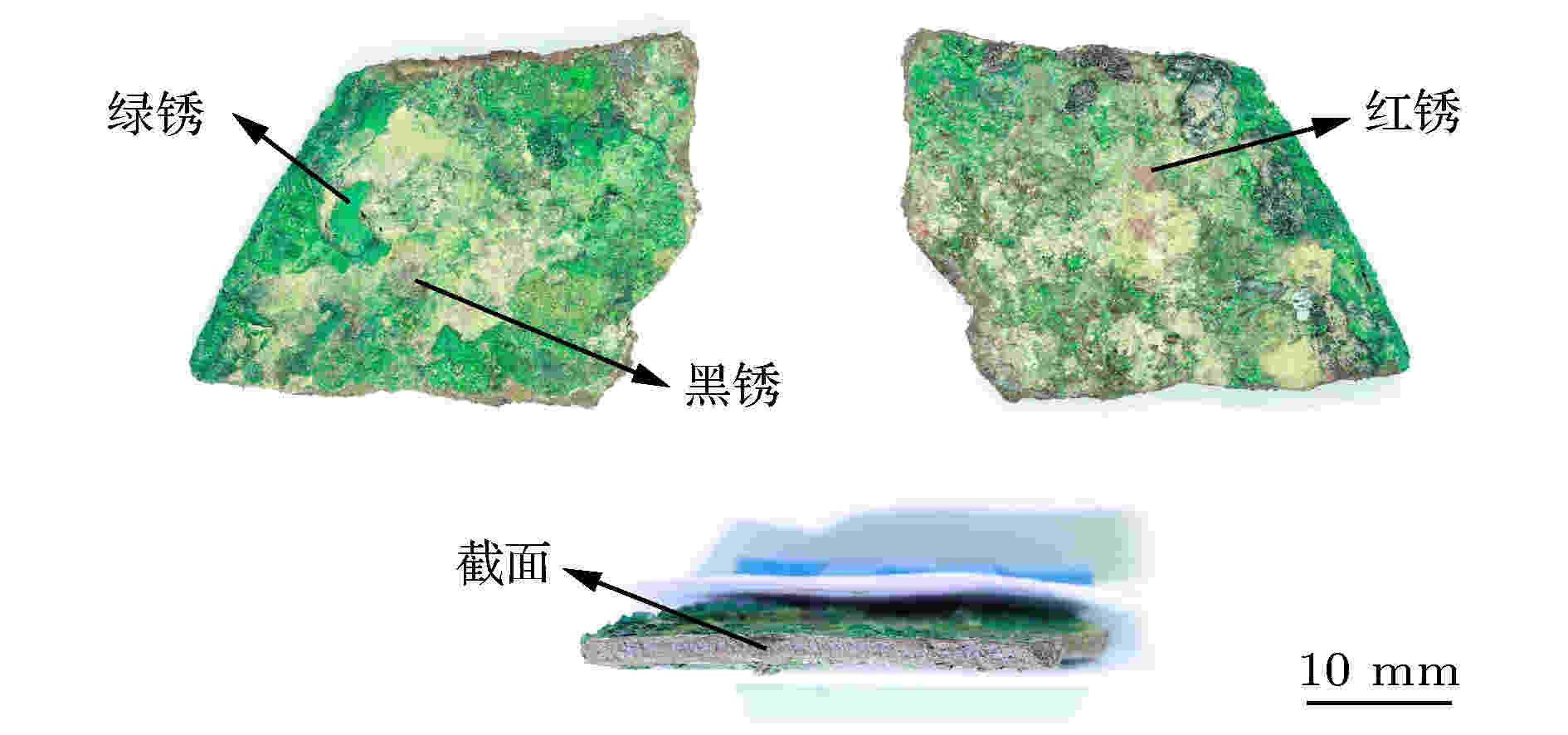 图 10 西汉青铜及其测试点
图 10 西汉青铜及其测试点Figure10. A piece of bronze produced in western Han Dynasty and the detected points.
研究表明, 青铜是以Cu, Sn和Pb为主要元素的合金铸造而成[18]. 为研究青铜锈蚀产物的物相组成, 对四个待测点分别进行X射线衍射分析, 各个探测点的照射X射线束斑直径如表3所示. 测得的衍射图如图11所示, 实验条件为: 电压30 kV, 电流30 mA, 步距角0.15°, 探测时间5 s. 通过分析测得的衍射图并与标准PDF卡片对比, 得到四个测试点的矿物晶相呈现在图11中: 绿锈中主要含有孔雀石(Cu2 (OH)2 CO3, JCPDS 41-1390)、白铅矿(PbCO3, JCPDS 52-1527)等的晶相; 黑锈中主要含有黑铜矿(CuO, JCPDS 48-1548)、一种铜锡合金(Cu10Sn3, JCPDS 26-0564)、白铅矿、孔雀石等的晶相; 红锈中主要含有赤铜矿(Cu2O, JCPDS 03-0892)、块黑铅矿(PbO2, JCPDS11-0548)、黑铜矿等的晶相; 截面中主要包含铜锡合金(Cu10Sn3)、黑铜矿、辉铜矿(Cu2S, JCPDS 32-0348)、铅丹(Pb3O4, JCPDS 41-1493)等的晶相[19-21].
| 锈蚀点 | 照射X射线束斑直径/μm |
| 绿锈 | 1300 |
| 红锈 | 680 |
| 黑锈 | 1000 |
| 截面 | 800 |
表3各探测点的X射线束斑直径
Table3.X-ray Beam diameter of each detected points.
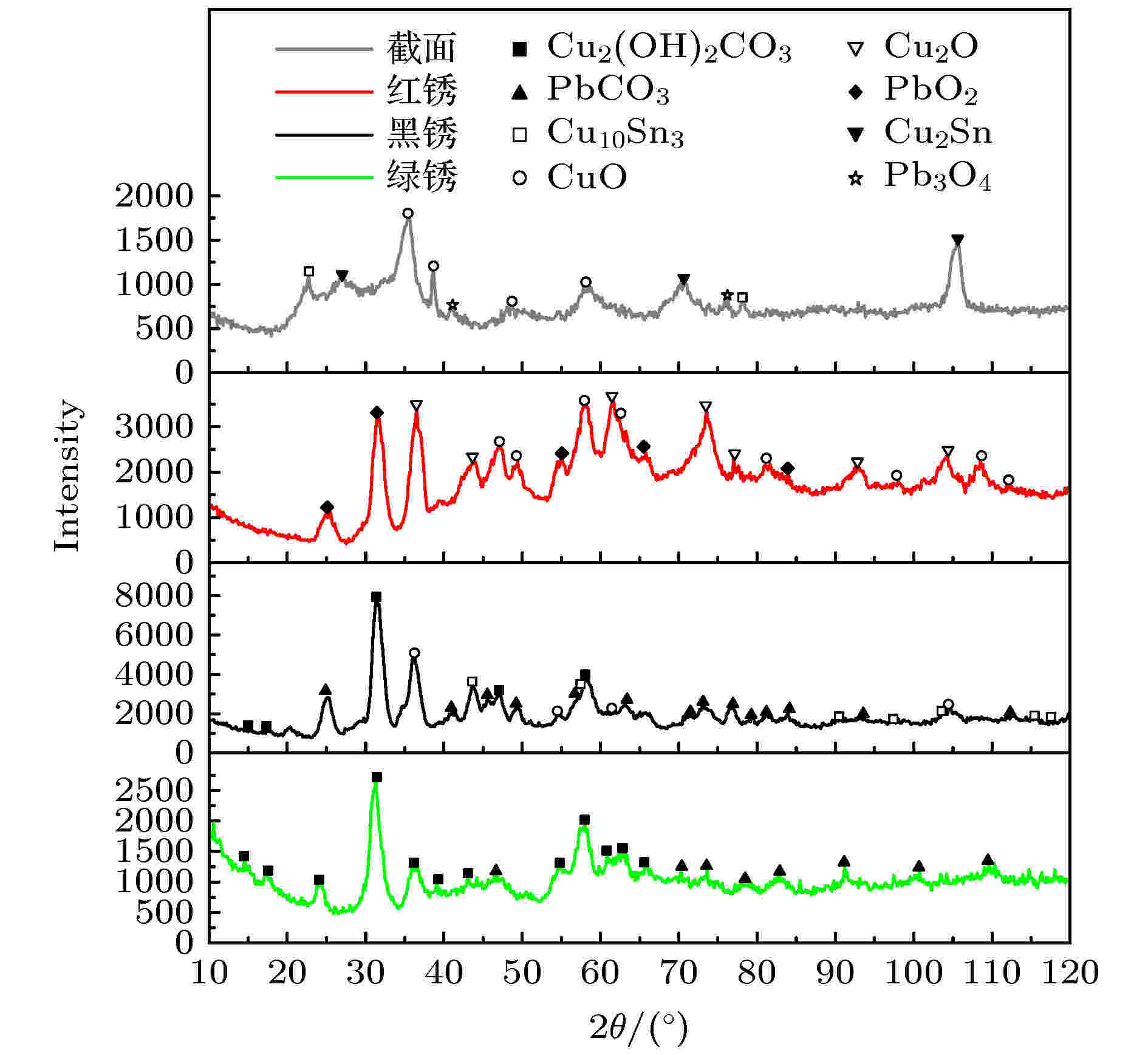 图 11 西汉青铜表面锈蚀区域和截面的XRD图
图 11 西汉青铜表面锈蚀区域和截面的XRD图Figure11. XRD patterns of corrosion area and section of bronze surface of Western Han Dynasty.
根据测得的XRD数据分析可知, 这片西汉青铜残片主要锈蚀产物为孔雀石、黑铜矿、赤铜矿、辉铜矿、白铅矿和铅丹等[19-21]. 青铜在长期掩埋地下的过程中, 基体的表面吸附了介质中的各种离子, 其中Cl-随青铜本身的缺陷如小孔、缝隙渗入内部引发孔蚀并导致环境成酸性, 从而进一步加快了锈蚀过程, 而

此外, 毛细管微会聚X光透镜的使用让照射点的X光强度提升了几十倍, 使得Hawk-II在2 s的探测时间也能取得峰形很好的衍射图, 比X-pert-pro-MPD 20 s的探测时间节省了近十倍的测量时间, 并且Hawk-II采集的衍射图本底更低, 拥有更好的峰背比. 在X射线衍射分析中峰位的准确性直接影响到晶相分析是否正确, 而衍射峰半高宽影响的只是峰的成型, 所以本衍射测得的衍射峰略宽但并不影响数据的准确性. 常规X射线衍射仪照射区域过大且无法改变, 常常超出目标探测区域, 导致探测到的物相包含有其他区域的物相, 使得分析的结果不够准确; 而微束衍射仪的X射线束斑过小, 不能包含待测区域内所有的物相信息并且无法满足常规分析的需求. Hawk-II可以根据待测点的大小来改变照射X射线束的直径, 使得X射线照射区域与待测区域相符, 从而实现对样品物相信息的精准分析. 同时Hawk-II具备的能量色散X射线荧光分析功能为X射线衍射分析提供元素信息, 加快了物相检索的过程.
非常感谢中国科学院大学考古学与人类学系罗伍干教授提供的西汉青铜碎片样品.
